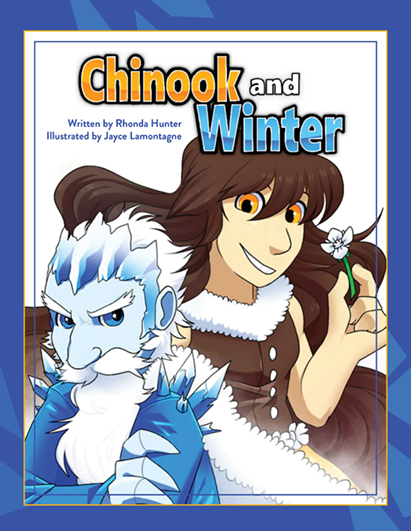| ________________
CM . . .
. Volume XXIV Number 4. . . September 29, 2017
excerpt:
In Chinook and Winter, Rhonda Hunter and Jayce Lamontagne personify the seasonal occurrences of Chinook and Winter. Chinook is portrayed as a bright, young, playful girl while Old Man Winter is a sneaky, cruel, and unfeeling cheater. The story begins by introducing Chinook and Old Man Winter, and explains how Winter takes over the Canadian prairies every year, but Chinook will always come out for a few days to dance and play with Winter and push him back temporarily. This occurrence is referred to by the book’s characters as an Indian summer. However, this year Winter cheats and comes early in an attempt to rule over the entire season uninterrupted. His “icicle fingers”, “snow cloak”, and “cold breath” cover the land just as children are starting school for the year. Kiaya and her mom watch from their window as snow covers the land. When Kiaya wonders why the snow is falling so early, her mom reassures her that an Indian summer will come. She tells Kiaya that, when she was little, they would call on Chinook to come and give them a reprieve from winter, and she shares a simple rhyme with her daughter. In the beginning, everyone is happy and enjoying the early snowfall, but, as the days drag on and it gets colder and colder, people begin to resent Winter. They call on Chinook to come for some relief, and she finally awakens from her slumber to come out and play with Winter. The people are overjoyed, but Old Man Winter is terribly angry that the people love Chinook more than they love him. He bullies Chinook back into her den and ruthlessly takes over once again without a care for the peoples’ feelings. When Winter sees Kiaya give her mother a heart and her love on Valentine’s Day, Winter pretends he is unaffected, but he secretly begins to miss Chinook and their playful friendship. Eventually Old Man Winter, himself, calls on Chinook and humbly admits he needs her and asks her to play with him once again. Chinook and Winter has many positives, and it could be used in a number of ways, but it would be best used as a teacher-led resource. It touches on the themes of bullying, humility, asking for and receiving forgiveness, and playing fair. The book offers a wide variety of difficult language which can result in discussion around new vocabulary. It could be an accompaniment or lead-in to a weather unit, or to introduce chinooks and/or winter. At the end of the book, there is an informational page about the chinook weather phenomenon which explains how to identify one, what it does, and which provinces are affected by it. The illustrations are bright and colourful, and Lamontagne’s digital art, which bears some resemblance to anime, will appeal to many students. The book also has a nice linear progression of the seasons/months of the year with familiar markers for students who are still memorizing the order of months. Unfortunately, the book’s format (picture book) does not seem to match well with the corresponding story. The idea of picture book suggests a younger reading audience (primarily K-2), and the language in this book is too difficult for this age range. The story also does not lend itself well to a read-aloud as it is too long to hold a younger audience’s attention. The grade level that seems best suited to this book (grades 3-5) often do not gravitate towards illustrated fiction anymore as such books seem too ‘simple’ for their expanding reading repertoire. As a result, as mentioned, Chinook and Winter would be best used as a teacher-led resource. Another area that seems lacking in this story is the slight, then noticeably absent, reference to an underlying indigenous element. Pemmican Publications proclaims their commitment to promoting Métis culture, heritage, authors, illustrators, and stories, but this story seems to fall short on the educational aspect. There are a couple moments that make readers wonder whether or not this story is baseed on an indigenous legend, but there is no elaboration on whether this is actually a Métis or aboriginal story. This element would have been welcomed. Those familiar with First Nations legends may pick up on the subtleties (and these subtleties may be viewed as positives in these situations), but without background knowledge on the reader’s side, this book might not do well as a stand-alone for Métis, First Nations, or Aboriginal culture or legends because of the lack of informational content and non-traditional illustrations. While Chinook and Winter attempts to fill an ever-present gap in aboriginal literature, it seems better suited for other applications. Recommended with Reservations. Dawn Opheim, an avid reader with a Masters degree in teacher-librarianship, works at two elementary school libraries in Saskatoon, SK.
To comment
on this title or this review, send mail to cm@umanitoba.ca.
This Creative Commons license allows you to download the review and share it with others as long
as you credit the CM Association. You cannot change the review in any way or use it commercially. Commercial use is available through a contract with the CM Association. This Creative Commons license allows publishers whose works are being reviewed to download and share said CM reviews provided you credit the CM Association.
Next Review | Table of Contents For This Issue - September 29, 2017 |
